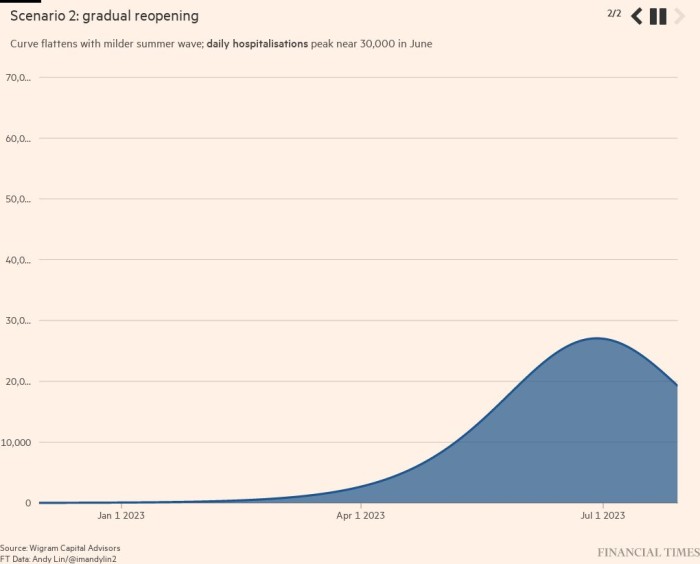[ad_1]
One million Chinese people are at risk of dying from Covid-19 during the coming winter months if President Xi Jinping pursues his pivot to remove strict pandemic controls, new modelling shows.
In a stunning reversal after protests against Xi’s zero-Covid policy, Chinese officials have over the past week started dismantling the pandemic control system of lockdowns, mass testing, state quarantine and electronic contact tracing.
Removal of the restrictions risks sparking an unparalleled “winter wave” of Covid infections that would rapidly overwhelm China’s healthcare system, according to projections by Wigram Capital Advisors, an Asia-focused macroeconomic advisory group that has provided modelling to governments during the pandemic. The models have been reviewed by the Financial Times.
Under a scenario where China’s leadership continues to roll back zero-Covid — as it has been doing in Beijing, Shanghai and Guangzhou among other cities in recent days — daily fatalities may reach as high as 20,000 in mid-March. Demand for intensive care units would peak at 10 times higher than capacity by late March and daily hospitalisations would hit 70,000.
The winter wave would be exacerbated by the likelihood of the lunar new year holiday, the world’s largest annual human migration, becoming a super spreader event.
The projections highlight Beijing’s failure to administer full vaccine courses to tens of millions of elderly Chinese and address the country’s ICU shortage nearly three years since the first Covid cases emerged in Wuhan, central China, in late 2019.
It also returns focus to the Xi administration’s refusal to import superior messenger RNA vaccine technology.
That is despite months of warnings from health experts as well as modelling by researchers at Shanghai’s Fudan University, released in May, which estimated that an unchecked surge of the Omicron variant in the country of 1.4bn people could lead to almost 1.6mn fatalities within about three months.
“The current propaganda messaging is that a reopening will be costless,” said Rodney Jones, principal at Wigram. “The risk is that they are underestimating just how much work — and cost — the rest of the world has done and borne to get to the point of living with Covid.”
The Wigram models use vaccination and age data, the effect of public health measures and the real-time effective “R value”, a measure of a disease’s ability to spread between people. It also uses the experiences of Singapore, Australia, New Zealand and Hong Kong.
For China to also achieve hybrid immunity from infection and vaccinations, which would allow the economy to operate freely, 20 per cent of the population or 290mn people would have to be infected. Given the lack of reporting for positive cases, infections would in reality be 50 per cent higher, at about 30 per cent of the population or 435mn people.
Under a scenario of a more gradual and controlled reopening, the process of reaching hybrid immunity would take until August next year, the Wigram modelling showed. This would help cap hospitalisations and deaths until mid-2023.
During a “summer wave”, the peak daily death toll would be halved, to about 4,000, striking in July 2023. Total hospitalisations would also be contained at a highest point of 200,000, compared with 500,000 in a winter wave.
“China has done nothing to prepare for this step, and Xi appears to be doing so on impulse as a reaction to the protests, rather than as part of a careful policy programme,” Jones said.
“It would be easier to have confidence in a reopening strategy if it was happening as part of a careful policy strategy, not on impulse, with no preparation.”
Goldman Sachs’s baseline scenario is that Beijing will only meaningfully relax Covid controls from around the second quarter of next year, after completing medical preparations including vaccinating the elderly.
However, the investment bank said there was now about a 35 per cent probability that Xi would be forced into “effective reopening with control” in which China launched a de facto reopening immediately while attempting to stagger the changes so that the health system could cope.
[ad_2]
Source link
